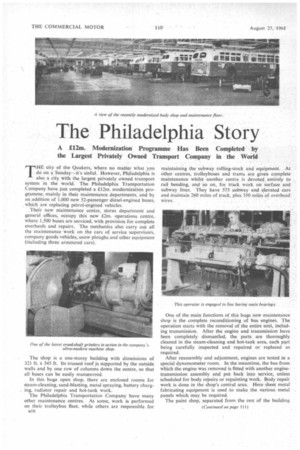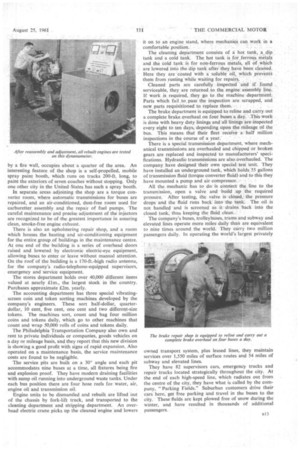The Philadelphia Story
Page 44

Page 47

If you've noticed an error in this article please click here to report it so we can fix it.
A £12m. Modernization Programme Has Been Completed by the Largest Privately Owned Transport Company in the World
THE city of the Quakers, where no matter what you do on a Sunday—it's sinful. However, Philadelphia is also a city with the largest privately owned transport system in the world. The Philadelphia Transportation Company have just completed a £12m. modernization programme, mainly in their maintenance departments, and by an addition of 1,000 new 52-passenger diesel-engined buses. which are replacing petrol-engined vehicles.
Their new maintenance centre, stores department and general offices, occupy this new £2m. operations centre, where 1,500 buses are serviced, with provision for complete overhauls and repairs. The mechanics also carry out all the maintenance work on the cars of service supervisors, company goods vehicles, snow ploughs and other equipment (including three armoured cars).
The shop is a one-storey building with dimensions of 321 ft. x 345 ft. Its trussed roof is supported by the outside walls and by one row of columns down the centre, so that all buses can be easily manceuvred.
In this huge open shop, there are enclosed rooms for steam-cleaning, sand-blasting, metal spraying, battery charging, radiator repair and hot-tank work.
The Philadelphia Transportation Company have, many other maintenance centres. At some, work is performed on their trolleybus fleet, while others are responsible for RIO maintaining the subway rolling-stock and equipment. At other centres, trolleybuses and trams are given complete maintenance whilst another centre is devoted entirely to rail bending, and so on, for track work on surface and subway lines. They have 575 subway and elevated cars and maintain 260 miles of track, plus 350 miles of overhead wires.
One of the main functions of this huge new maintenance shop is the complete reconditioning of bus engines. The operation starts with the removal of the entire unit, including transmission. After the engine and transmission have been completely dismantled, the parts are thoroughly cleaned in the steam-cleaning and hot-tank area, each part being carefully inspected and repaired or replaced as required.
After reassembly and adjustment, engines are tested in a special dynamometer room. In the meantime, the bus from which the engine was removed is fitted with another enginetransmission assembly and put back into service, unless scheduled for body repairs or repainting work. Body repair work is done in the Shop's central area. Here sheet metal fabricating equipment is used to make the various metal panels which may be required.
The paint shop, separated from the rest of the building by a fire wall, occupies about a quarter of the area. An interesting feature of the shop is a self-propelled, mobile spray paint booth, which runs on tracks 200-ft. long, to paint the exteriors of seven coaches without stopping. Only one other city in the United States has such a spray booth.
In separate areas adjoining the shop are a torque converter room, where automatic transmissions for buses are repaired, and an air-conditioned, dust-free room used for carburetter assembly and the repair of fuel pumps. The careful maintenance and precise adjustment of the injectors are recognized to be of the greatest importance in assuring clean, smoke-free engine exhaust.
There is also an upholstering repair shop, and a room which houses the heating and air-conditioning equipment for the entire group of buildings in the maintenance centre. At one end of the building is a series of overhead doors raised and lowered by electronic electric-eye equipment, allowing buses to enter or leave without manual attention. On the roof of the building is a 170-ft.-high radio antenna, for the company's radio-telephone-equipped supervisors, emergency and service equipment.
The stores department holds over 40,000 different items valued at nearly Lim., the largest stock in the country. Purchases approximate £2m. yearly.
The accounting department has three special vibratingscreen coin and token sorting machines developed by the company's engineers. These sort half-dollar, quarterdollar, 10 cent, five cent, one cent and two different-size tokens. The machines sort, count and bag four million coins and tokens daily, which go to other machines that count and wrap 50,000 rolls of coins and tokens daily.
The Philadelphia Transportation Company also own and rent to private individuals or companies, goods vehicles on a day or mileage basis, and they report that this new division is showing a good profit with signs of rapid expansion. Also operated on a maintenance basis, the service maintenance costs are found to be negligible.
The service pits are built on a 30° angle and each pit accommodates nine buses at a time, all fixtures being fire and explosion proof. They have modern draining facilities with sump oil running into underground waste tanks. Under each bus position there are four hose reels for water, air, engine oil and transmission oil.
Engine units to be dismantled and rebuilt are lifted out of the chassis by fork-lift truck, and transported to the cleaning department and stripping department. An overhead electric crane picks up the cleaned 'engine and lowers it on to an engine stand, where mechanics can work in a comfortable position.
The cleaning department consists of a hot tank, a dip tank and a cold tank. The hot tank is for ferrous metals and the cold tank is for non-ferrous metals, all Of which are lowered into the dip tank after they have been cleaned. Here they are coated with a soluble oil, which prevents them from rusting while waiting for repairs.
Cleaned parts are carefully inspected and if found serviceable, they are returned to the engine assembly line, if work is required, they go to the machine department: Parts which fail to, pass the inspection are scrapped, and new parts requisitioned to replace them. .
The brake department is equipped. to reline and carry out a complete brake overhaul on four, buses a day. This work is done with heavy duty linings and all linings are inspected every eight to ten days, depending upon the mileage 'of the bus. This means. that their fleet receive a half million inspections in the course of a year.
There is a 'special transmission department, where mechanical transmissions are overhauled and chipped or broken gears are replaced and inspected to manufacturers' specifications. Hydraulic transmissions are also overhauled. The company have designed their own special test unit. They have installed an underground tank, which holds 55 gallons of transmission fluid (torque converter fluid) and to this they have mounted a pump and air compressor. : All the mechanic has to do' is connect the line to the transmission, open a valve and build up the required pressure. After testing, the valve is closed,. the pressure drops an'd the fluid runs back' into the tank. The oil is not handled and is screened as it drains back into the closed tank, thus keeping the fluid clean'.
The company's buses, trolleyhtises, trams and subway and elevated lines operate more miles daily than are equivalent to nine times around the world. They carry two million passengers daily. In operating the world's largest privately owned transport system, plus leased lines, they maintain services over 1,550 miles of surface routes and 54 miles of subway and elevated lines.
They have 82 supervisors cars, emergency trucks and repair trucks located strategically throughout the city. At the end of each high-speed line, which radiates out from the centre of the city, they have what is called by the company, "Parking Fields." Suburban customers drive their cars here, get free parking and travel in the buses to the city. These fields are kept plowed free of snow during the winter, and have resulted in thousands of additional passengers.




















































































































